In this tutorial we’re going to introduce the Dashboard and go over the first few settings you should adjust when you are setting up your site for the first time, and we’ll finish today’s lesson with the absolute basics on creating your first pages and posts (including a bit of a look at the differences between the two).
Before We Start
You’ll need:
- Your log in credentials for your WordPress site.
Here’s an outline of what we’ll be looking at today:
- Introducing the Dashboard
- Some basic general settings
- Mapping out your site structure
- Understanding posts and pages (different content types)
- Creating a page
- Creating a post
- Setting static pages for home and blog pages
Introducing the Dashboard
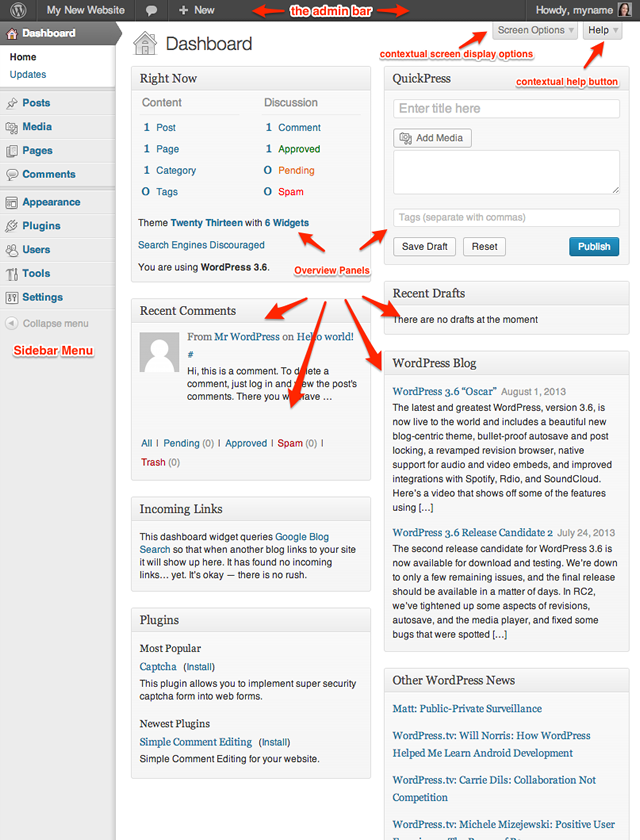
Ok, when you first log into your site you’ll be redirected to the Dashboard, the basic control panel from which you will drive your site. From here there are a bunch of places you’ll get familiar with fairly quickly as you begin to manage the content. One of the things you’ll notice in WordPress is that there are often many ways to get to the same place, the way you use it will depend on what works for you. Let’s start with a bit of a quick run through.
At the very top of the page is the Admin Bar, and as with most of WordPress, the content in this bar is context sensitive, as in, what appears in this area will depend on where you are within WordPress. If you are in the Dashboard, as we are in this first image, you’ll be able to hover over the links in the admin bar and get access to the following areas:
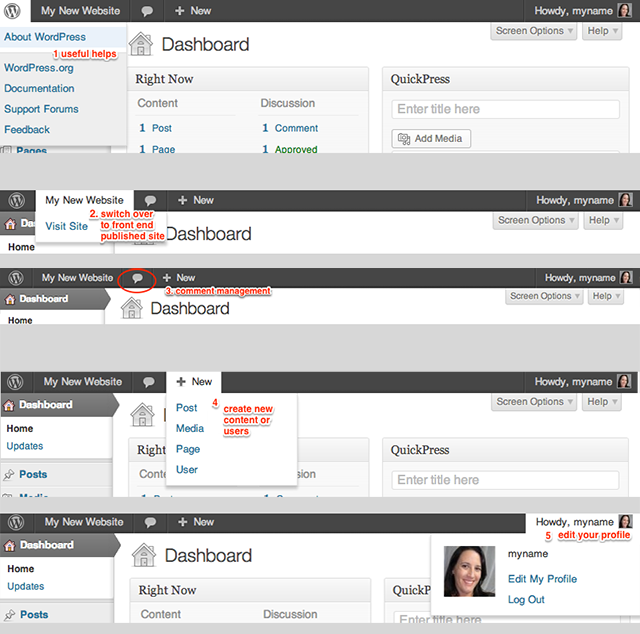
- The WP logo shows you links to useful helps (See Fig. 2).
- The Site Title (in my case, “My New Website”) leads to a published view of your site.
- Comments ready for publishing
 (no comments currently requiring attention)
(no comments currently requiring attention) - New content / users
- Your own user management and log out button.
If you are elsewhere in the site, the options available in the Admin Bar will change. Here’s how it looks in the front end (all the other buttons remain the same):
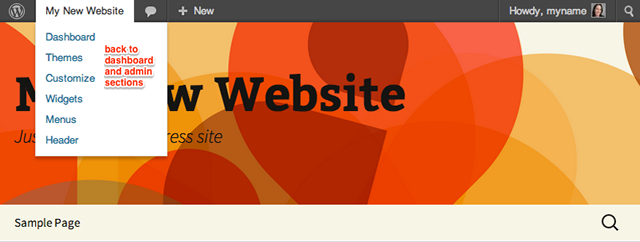
Now, rather than focus on running through the various parts of the sidebars and menus as they read from top to bottom, we’re going to focus on the things that are smart to do from the get-go; things that help get your site ready for market rather than just learning how to do WordPress.
So go ahead and hit the ‘Settings’ link near the bottom of that sidebar menu.
Some Basic General Settings
First, let’s set the date and timezone for your site.
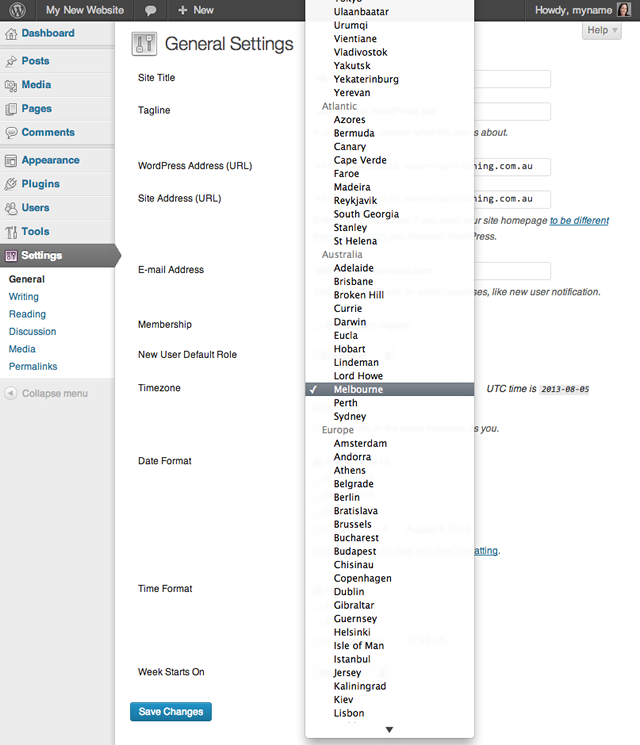
When you hit the settings page you’ll see the Timezone setting halfway down. You can choose to set the timezone according to your time relative to UTC or you can can scroll up the list to find your city and set the time using that (the benefit of this is that it will change with Daylight Saving). You can see here that I’ve set the timezone to Melbourne – the equivalent UTC code would be +10.
Next we’ll change the permalink settings. This alters the URLs on our site from the default post id (e.g ?p=123) to reflect something a bit more meaningful for both readers and for search engines. In this case we’re using just the post name for our permalinks.
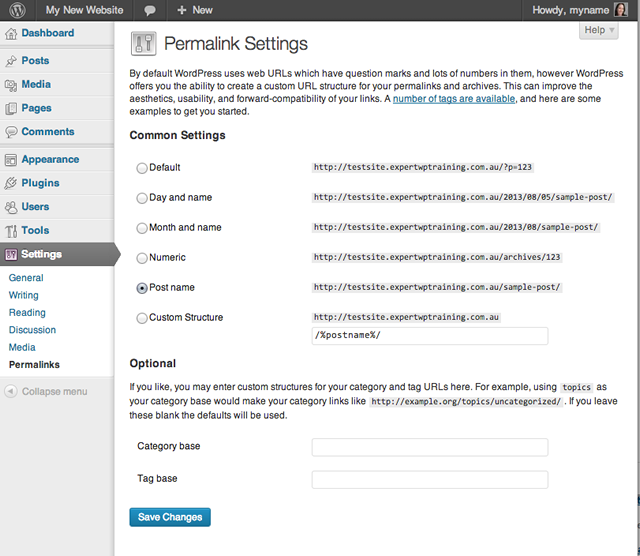
Now that the basics are good to go, let’s look at adding content.
Mapping Out Your Site Structure
Now, one of the things I see happening with new WordPress sites is people diving in and creating pages and posts without really having any clear plan of attack, and if your site is a playful project that’s about getting familiar with messing about in WordPress, well that might be fine. However, if you’ve got plans for your site, it is a much better practice to have a plan for your content and site structure before you dive in and create stuff willy nilly.
For this first example site, which is a personal blog site, we’ve a couple of different kinds of content we’re going to want to use, and we’ve got a site structure in mind that looks something like this:
- Home – A listing of my latest blog posts
- About Page – Why this site exists with a short bio about the site owner
- Contact Page – Predictably where to find me and how to get in touch
Most sites start out looking something like this and content evolves as the site does. However, the way you structure the site may well depend on how you’re wanting to use it. In this case it’s a personal blog for sharing thoughts, cool internet finds, favourite quotes and videos etc. But your site may be a business site and your blog may be secondary and not require a front page spot. Setting your site up for that requires a setting change, but before we go there we’re going to talk about the differences between posts and pages, then you might be better placed to decide which way you’re going to structure your front page.
Understanding Posts and Pages (i.e. Different Content Types)
Posts and Pages are both content types and while they have a lot of similarities there are also a few differences specific to each content type. To put it simply, the differences are not unlike different kinds of publications: Pages are like Books, Posts are like Magazines.
Enough, no?
OK, let’s dig a little deeper.
Pages generally hold content that is fairly static; once you’ve published it, while you may wish to be able to change it, it isn’t something that you’re going to have to edit regularly. It isn’t time sensitive and it remains in its place and usually will have a spot in your menu.
Pages are like a book on the bookshelf, their content is useful over the long term. They’re unlikely to change much, or very often, and they’re good to have easily accessible for reference.
Pages can also be built hierarchically in your site structure and you can apply different kinds of layout templates to them according to the templates available in your theme (and yes, this is kind of where the metaphor ends).
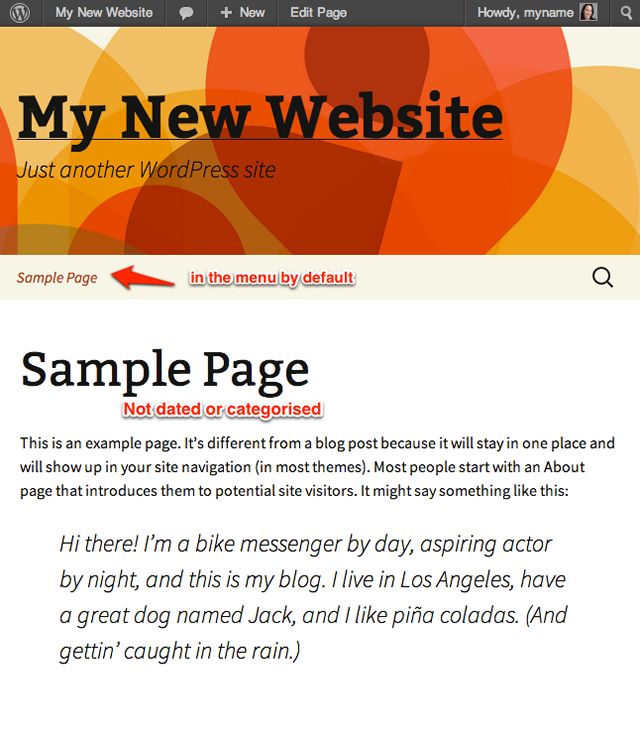
Posts on the other hand are time sensitive, they may be categorised, they will also be included in your RSS feed (people may subscribe to them). They will be displayed on your blog page, or front page, in reverse chronological order and they’re less likely to be needed to be included in your menu because of their more disposable nature.
See? Just like a magazine… time sensitive, usually stacked in order with the newest on the top, categorised by date and content type, and generally more interesting in the short term than the long.
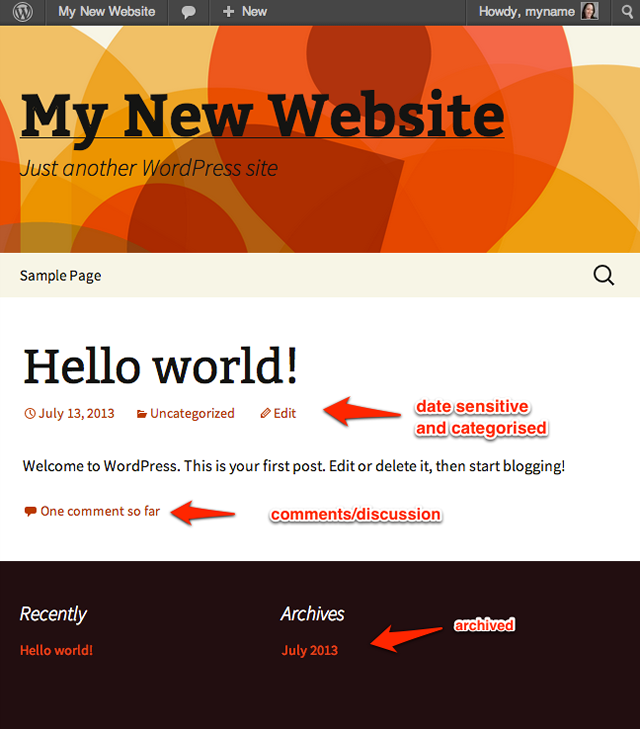
If it’s easier to have a visual representation of how that looks, here’s a graphic view in which you can see where there is cross over between the content types and where there are differences.
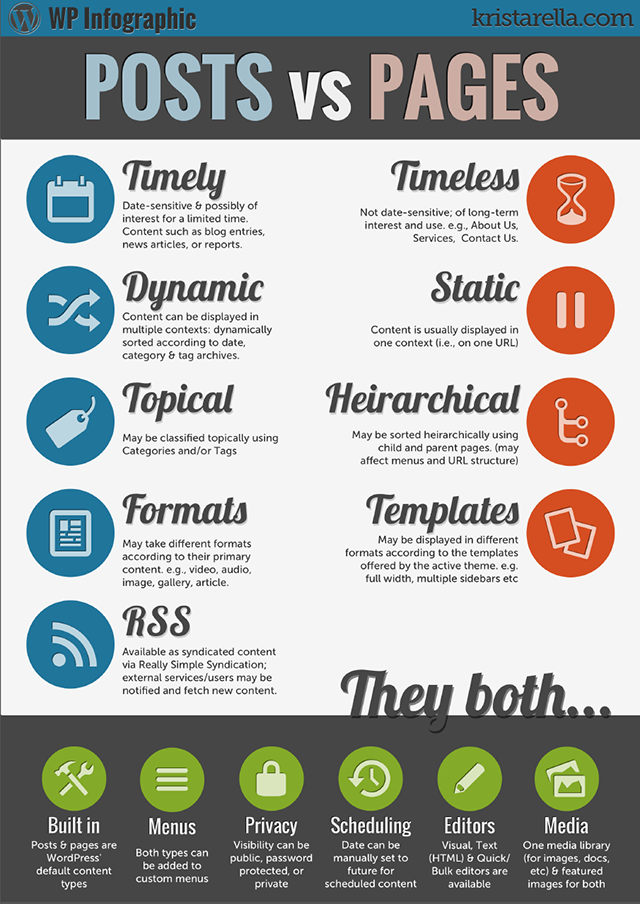
Creating a Page
So, there are several places you can go to create a Page. You can start with the Admin bar and hit the New link up there and a list will drop down, and one of the items you can create from there is a Page. If you’re in the Dashboard can also click on the Pages link in the Sidebar menu and choose the Add New page from there. OR, if you’ve clicked on the Pages link you may find yourself in the Pages listing section, you can see a link in the top of that which says Add New.
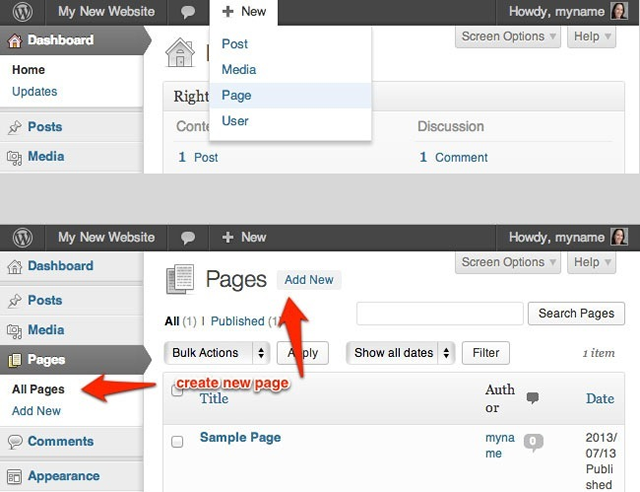
Any of these links will do the same thing, open up the page editor window.
There’s a lot about this window that should be reasonably sensible. If you’re familiar with word processing, then the options in the edit box should be clear enough. Put your cursor into the editor section and start typing! To add a paragraph at the end of your text just hit return or enter, if you only want to drop down half a step, hit shift and enter/return to simply put in a line break.
When your content looks like you want it to then hit Publish, if you’re not quite ready to publish and want save your content to come back to later then just hit the Save Draft button.
If you want to take a peek at what your page will look like when you’ve published it, then hit the Preview button (makes sense, right?). Go ahead and give it a whirl… I’ll wait…
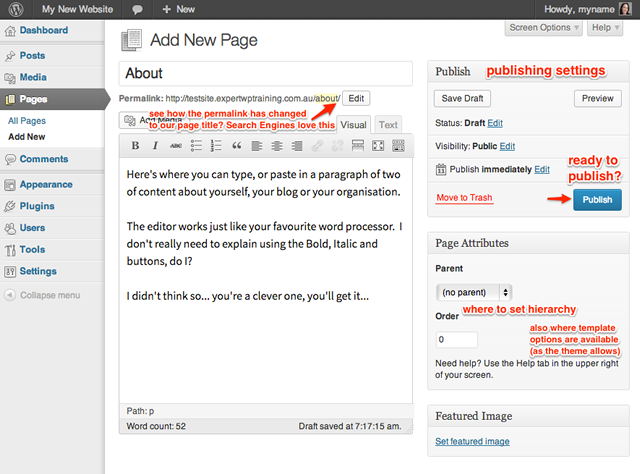
When you’ve created your About page and you’re happy with that then repeat the process and create a Contact Page.
Once you’ve done that then head over to View Site to have a look at your new pages!
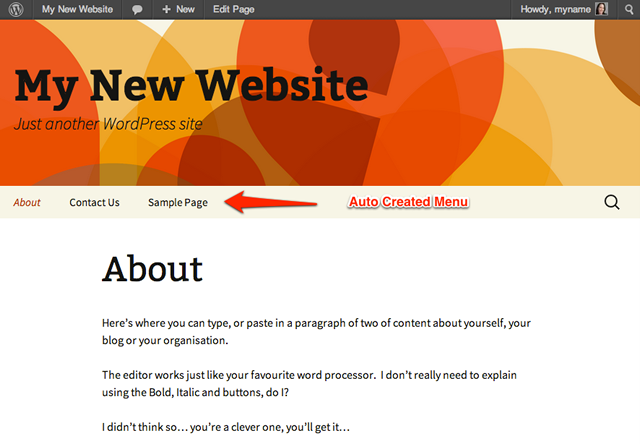
You may notice that your new pages have appeared in the menu by default and are listed in the order they’re created, with the newest at the front. We’ll get into how to edit and customise menus in a later tutorial, in the meantime, we’re going to add a new post – and here’s a secret… while there’s no home button in the menu (we’ll add that later) click on your site title to get back to the front page.
While you’re there, click on the New button and choose Post.
Creating a Post
Most of this page should look pretty familiar, right? There are some significant differences, but the important similarities are the Editor field and the Publishing section.
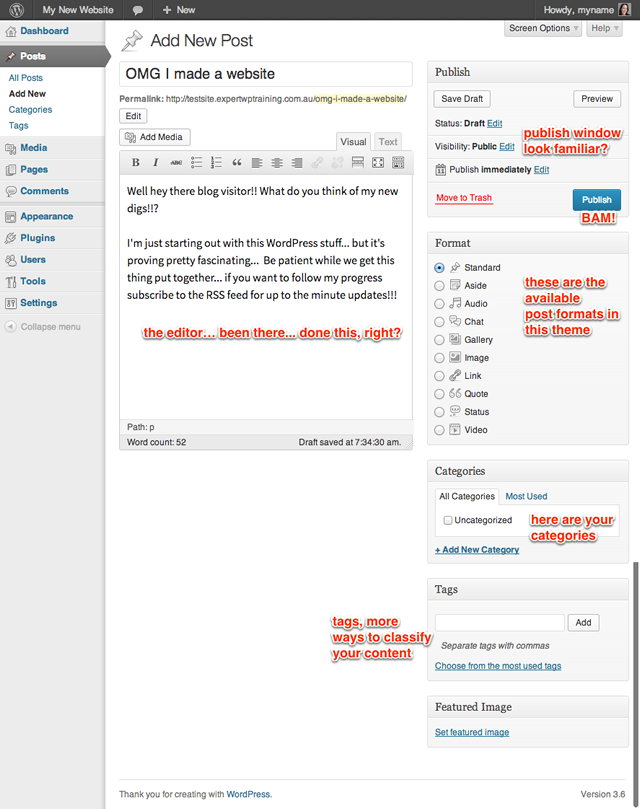
The different areas allow for different kinds of Post Formats and various ways of classifying your posts according to categories. We’ll break down Post Formats in the next tutorial, for now let’s just focus on classifying our post. As it is at the moment the post is set to the default category of ‘Uncategorized’. We’ll look at how to edit that in the next tutorial as well.
But, there you go, you’re now well underway for creating the basic structure and content for your website! Congratulations!!
But, you may have one more thing you’re wanting to do, and it would be wrong for me to leave you hanging, what if your site’s not a blog?! OK, let’s look at structuring your site with a static front page.
Setting Static Pages for Home and Blog Pages
So, now you know how to create pages and posts, and you might be having thoughts about how you want your front page structured. If you’re happy with having it listing your posts then you can bow out of the tutorial at this point and join us next time, but if you are wanting to know how to adjust your front page view for static page content and a separate blog page, then keep reading.
So, let’s say our site structure looks less like the above and looks more like this:
- Home – A static introductory page
- About Page – Why this site exists with a short bio about the site owner
- Services Page – A listing of the services I offer
- Blog Page – A listing of my latest blog posts or news articles
- Contact Page – Predictably where to find me and how to get in touch
In order to change where our blog listing happens and having a static page for your front page you have to actually create the static pages, and that’s easy. Following the same instructions as above, create three new pages. Call them Home, Blog, and Services just to make things easy. I haven’t put any content in them, in fact, don’t put anything on the blog page, but you will need to add content to the Home and Services pages when you’re ready.
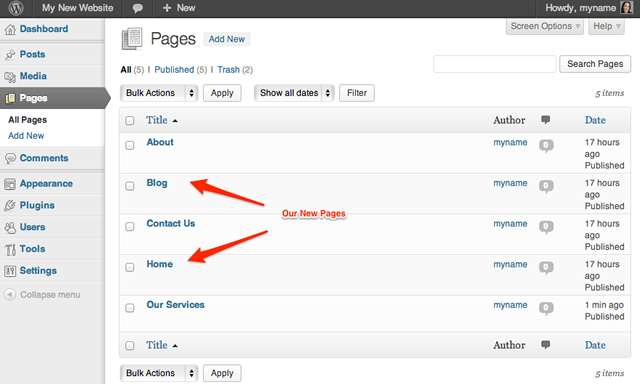
When that’s done then you need to hit up the Reading Settings page – when you’ve found that change the radio button that’s currently set to ‘Your latest posts’ to reflect the pages you want to become your Front Page and your Posts page. You might be able to see why we needed to create the pages first.
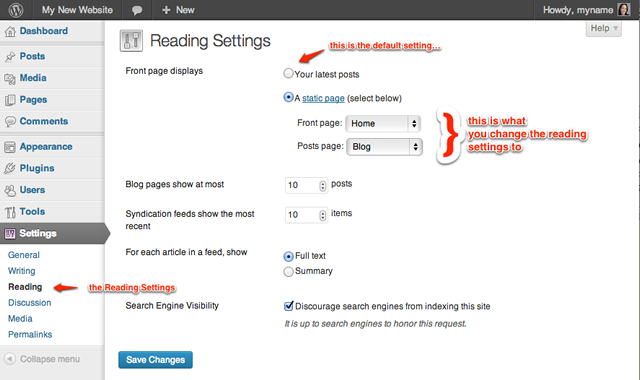
Once you’ve done that then hit Save Changes and hop over to your front page to see your changes in effect.
Would you look at that! Here’s my static Home page with no content in it:
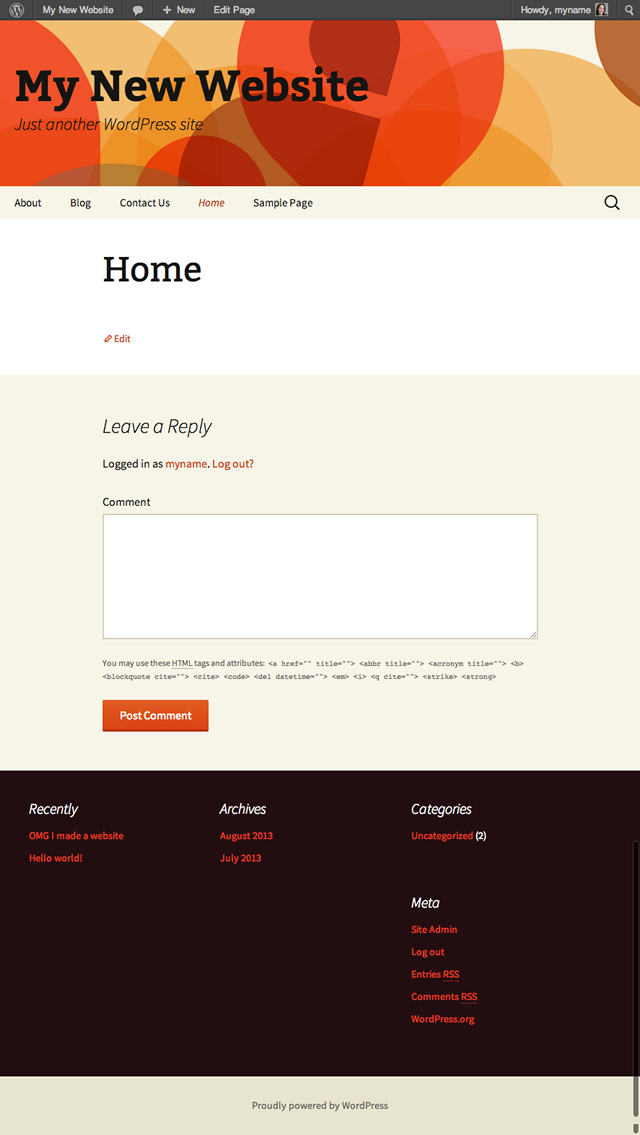
And here’s my blog page:
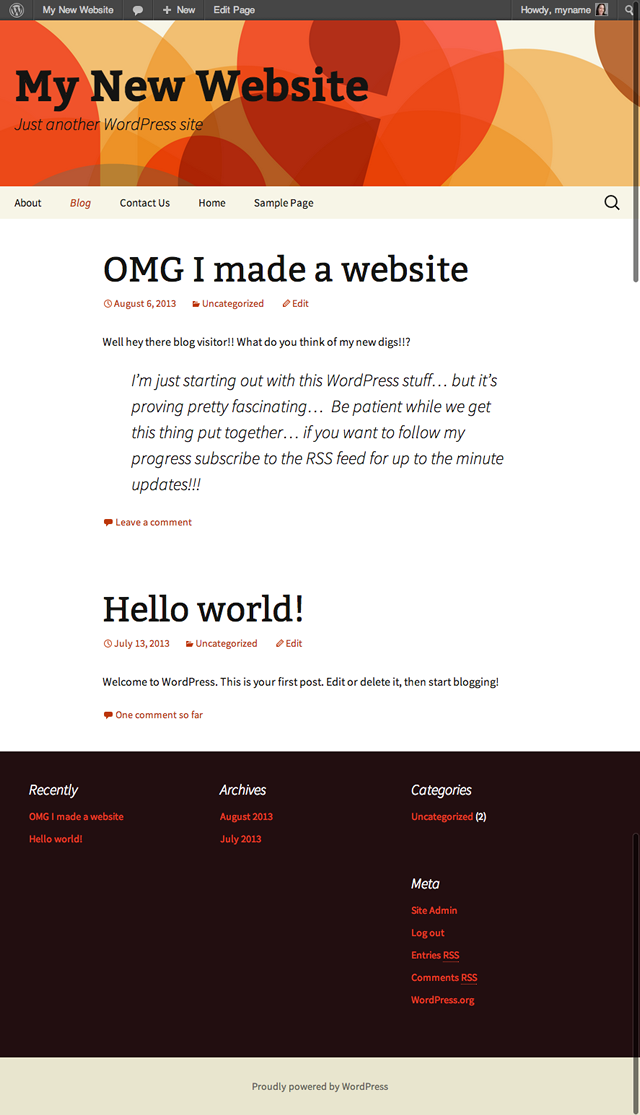
OK, we’ve got some tidying up to do. We’re going to want to remove comments from static pages for a start, we’re also going to want to tweak the menu, but that’s enough for today. We’ll get to some of those finer points of site tweaking next time!
Conclusion
Starting out your website project with a bit of a plan as to how your site’s going to be structured will save a lot of long term hassle wherein you could find yourself writing and rewriting posts and pages to make the site conform to your content.
Plan first, then build your site structure according to the content type be that content fit for pages or posts or a mixture of the two.
